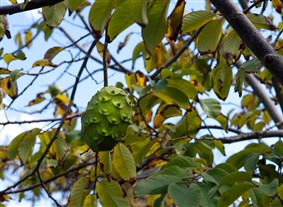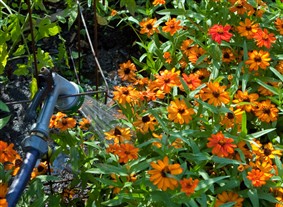Delectable Cherimoya
Views: 5899

Do you see this strange fruit hidden in the leaves? Look closely: the pale artichoke green fruit is as hard to find in this photo. It’s hanging on the tree.
I was lucky enough to traipse around on a friend’s avocado ranch near Santa Barbara recently. In addition to organic avocados, she also grows blood oranges, limes, persimmons, and cherimoyas.
What is a Cherimoya?
The cherimoya is a subtropical fruit tree originating in the Andes Mountains of Ecuador, Colombia, and Peru. It thrives in tropical regions at altitudes between 4,300 and 8,500 feet. Temperatures don’t freeze there, but there are enough cool days and cool nights. Such a climate is also found in the south facing Santa Ynez mountain range near Santa Barbara. Growers are now then finding an increasing market for the specialty fruit.
Cherimoyas are tricky to grow. In addition to needing the perfect sub-tropical or Mediterranean climate, the trees must be pollinated by hand. The small beetle thought to pollinate the flowers is nowhere to be found in California. And our bees are too fat to fit into the female flowers. So the trees must be pollinated by painstakingly dipping a fine paintbrush in one flower and then transferring the pollen to another flower.
Cherimoya trees don’t do well as container trees. They also don’t ship well. The ripe fruit is soft like an avocado and additionally doesn’t store for long periods.
How to Eat a Cherimoya
My friend gave me one of the prehistoric looking heart shaped fruits to take back to the place I was staying in Camarillo. Even such a short trip seemed to bruise it slightly. We were instructed to cut the fruit into fourths, remove the sparse black seeds and scoop out the white custardy flesh.
The taste was heavenly sweet—perfectly served by itself with no embellishments as an after-dinner dessert. The flesh was velvety smooth, with many fruity flavors at once: pineapple, strawberry, a little banana. The taste and texture reminded me of a Midwest native fruit called the paw paw. (I think the fruits are actually distantly related.)
Where to Find Them
I have never seen cherimoyas for sale. I had never even heard of such a fruit before last week.
Knowing the trouble and the rarity of the trees I would venture to guess if you find one for sale, it won’t be cheap. I can only say if you have the chance to purchase one or a few dreamy fruits—splurge. The delicious fruits are worth the cost. And if you are lucky enough to live on the coast of California, by all means, try planting a few trees.
Meet Jennifer Bartley
Jennifer Bartley grew up on a ravine near an ancient Indian mound. She remembers spending glorious childhood days picking wildflowers and playing in an old,…
Jennifer's Recent Posts

Hand Watering the Kitchen Garden








